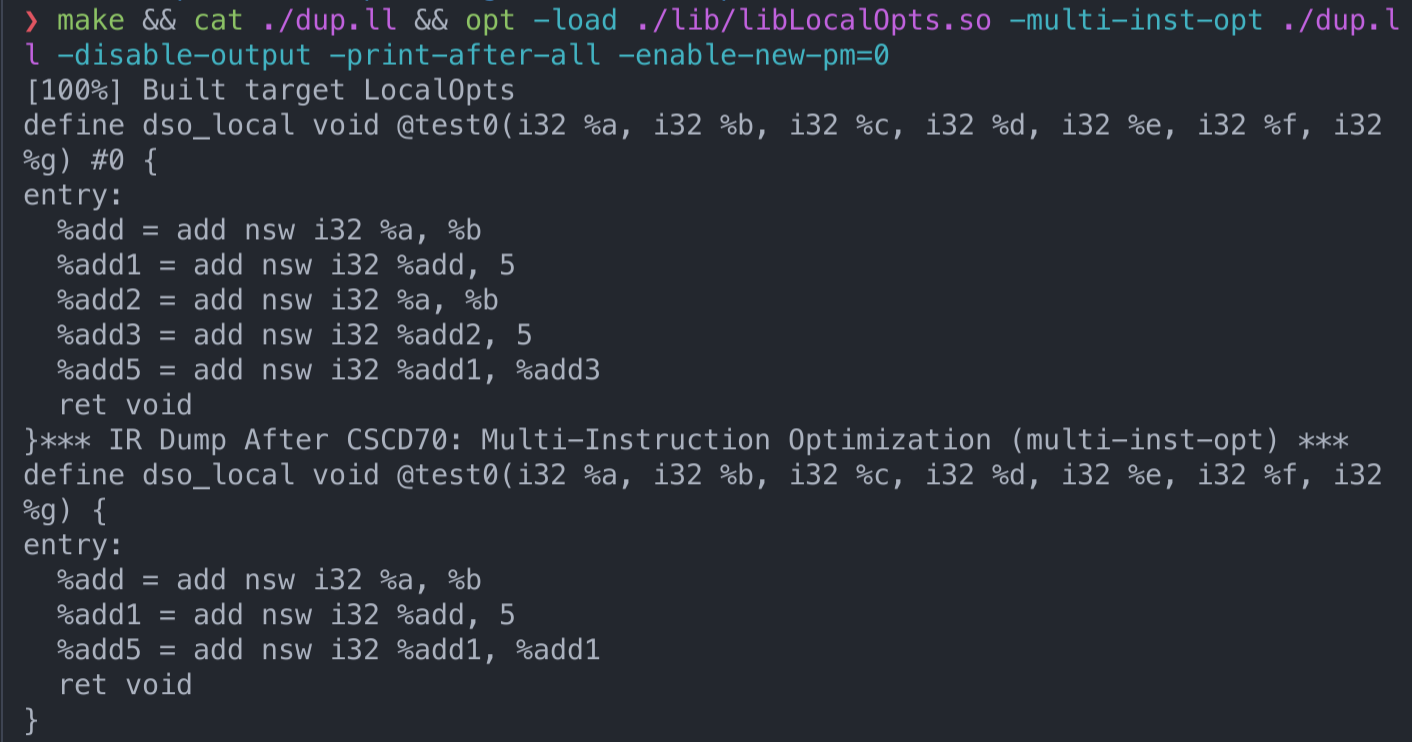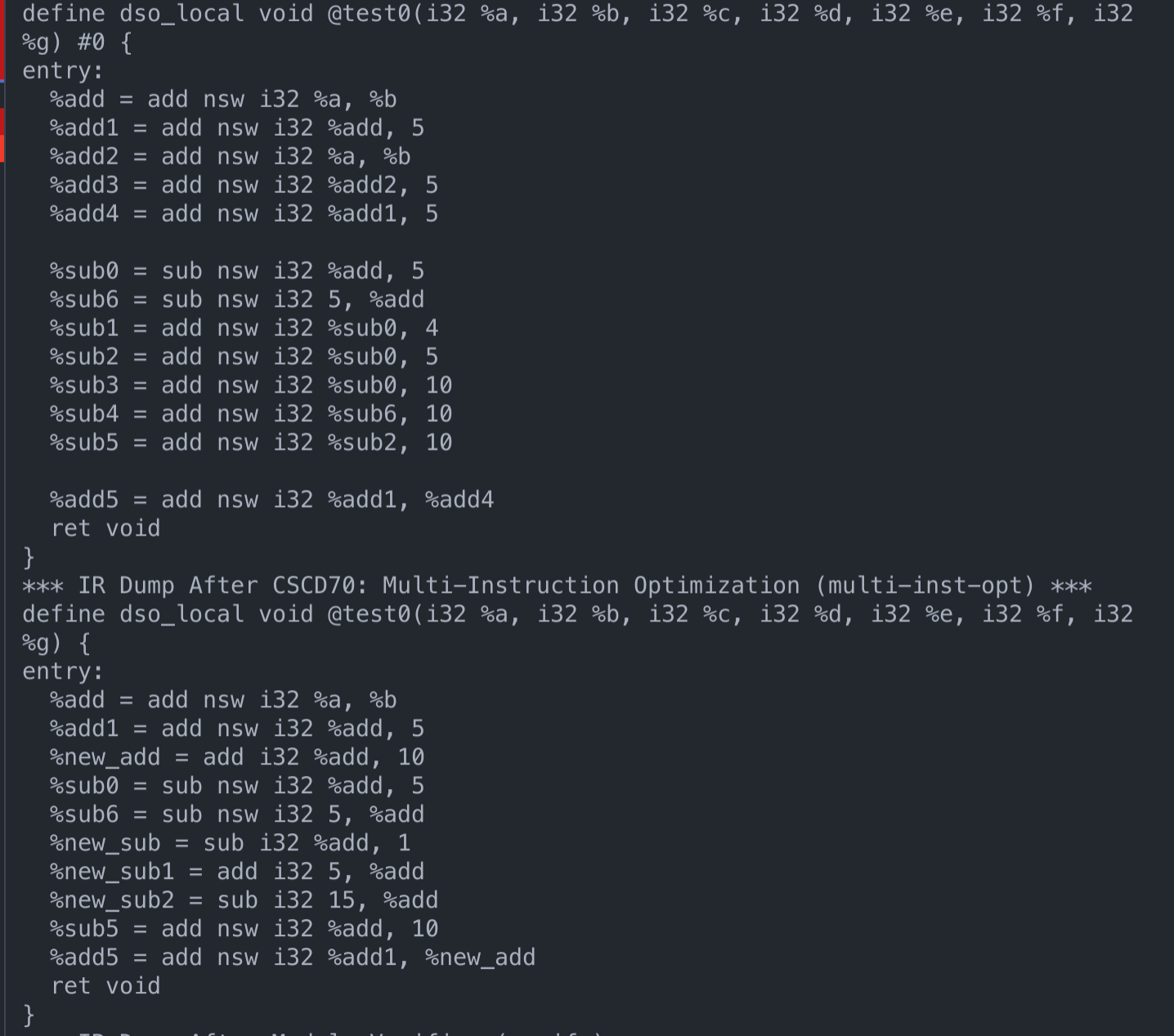 LocalOptimization
LocalOptimization
# local Optimization 理论&& llvm实现
# 基本概念
# BasicBlock
基本块, 在编译优化中,一个函数被划分为多个基本块, 一个基本块中有多个指令组成。
- 只有基本块中的第一个指令可以从其他块到达。 (也就是说基本快中不能存在分支)
- 所有的指令在基本块中都是顺序往下执行的。
在我们进行优化时, 最底层处理的是指令 Instruction, 指令构成基本块BasicBlock, 通过基本快中的跳转关系来表达条件或循环的逻辑关系,并构成函数Function。
在基本块中的优化称为 局部优化 Local Optimizations。
# Flow Graphs
程序控制流, 这是一个图结构,每个节点是一个基本块 BasicBlock,
第一个基本块称为start或entry节点,
# 基本块的划分
基本块的开头:
- 函数的首条指令
- 一个jmp的目标地址
- 一句jmp语句的下一行
确定了基本快的开头以后,每个基本块的结尾都是挨着基本块开头的,于是我们可以划分出基本块。
# 优化
# 优化的分类
算法优化 在一个指令中进行,比如a+0 => a,
局部优化, 在一个基本块中,指令间的关系。
全局优化, 在一个控制流中(或者说一个函数内), 基本块之间关系。
过程间优化, 在一个程序内,多个函数间优化。
# 局部优化
在一个基本块中的分析和转换,
局部优化的例子:
- 局部共同表达式消除
- 分析:相同的计算表达式出现多次
- 转换: 替换为一个
- 局部常量折叠或消除
- 分析:在编译过程中可以计算出来的数据
- 转换:直接替换为数据或者计算值
- 不可达代码消除
# 全局优化/过程间优化
- 全局形式的局部优化
- 全局共同表达式消除
- 全局常量折叠
- 全局不可达代码消除
- 循环优化
- 减少迭代中的计算
- 代码移位
- 归纳变量消除
- 其他控制结构
- 代码提升:
- 消除分支中重复代码。
- 代码提升:
# 局部优化
共同表达式消除, 主要有两种方案:
# 图形抽象
首先形成类似抽象语法树的树状结构, 然后链接合并相同变量,形成抽象图结构,
从图中获取表达式。
带来问题:
- 可能会有赋值语句出错
- 没有关于时间的对数值进行更新的处理。
# 变量编号
就是将变量进行编号,然后维护一个映射关系, 从变量到数据的映射关系,后续如果有对这个数据的使用,会先进行查表, 如果存在这个变量,则存在重复定义,可以进行优化, 如果不存在则可以插入到表里。
一般实现都是使用map/ hashtable,
但是要注意的是, 这个变量也要使用时间做一次标记,如果变量被更新了,不能与原来的算作同一个变量。
# 实现: cscd70: Assignment1
# FunctionInfo
这个比较简单,打印对应的信息即可。应该都在Function定义中,从Module依次获取,然后调用对应的方法即可。
virtual bool runOnModule(Module &M) override {
outs() << "CSCD70 Function Information Pass"
<< "\n";
/**
* @todo(cscd70) Please complete this method.
*/
outs() << "Name\t"
<< "#Args\t"
<< "#Calls\t"
<< "#Blocks\t"
<< "#Insts\t"
<< "\n";
for (auto Item = M.begin(); Item != M.end(); Item++) {
outs() << Item->getName() << "\t" << Item->arg_size() << "\t"
<< Item->getNumUses() << "\t" << Item->size() << "\t"
<< Item->getInstructionCount() << "\n";
}
return false;
}
2
3
4
5
6
7
8
9
10
11
12
13
14
15
16
17
18
19
20
21
# 0-UnuseOperation
这个是我自己写的,在测试的时候发现存在一些后续并没有被使用的代码,于是进行删除,其实思路也比较简单。
Instruction中有一个use_empty()方法,可以获取这个Instruction是否没有被使用过,如果是的话就可以进行删除了, 因为直接删除会出现问题,这里使用了个vector并在最后进行统一删除。
class UnuseOpt final : public FunctionPass {
private:
void deleteInstruction(std::vector<Instruction *> Insts) {
for (auto &Inst : Insts) {
if (Inst->isSafeToRemove())
Inst->eraseFromParent();
}
}
void runOnBasicBlock(BasicBlock &B) {
std::vector<Instruction *> DeleteInst;
for (auto &Inst : B) {
if (Inst.use_empty()) {
DeleteInst.push_back(&Inst);
}
}
deleteInstruction(DeleteInst);
}
public:
static char ID;
UnuseOpt() : FunctionPass(ID) {}
/**
* @todo(cscd70) Please complete the methods below.
*/
virtual void getAnalysisUsage(AnalysisUsage &AU) const override {}
virtual bool runOnFunction(Function &F) override {
for (auto &Item : F) {
runOnBasicBlock(Item);
runOnBasicBlock(Item);
}
return false;
}
}; // class
2
3
4
5
6
7
8
9
10
11
12
13
14
15
16
17
18
19
20
21
22
23
24
25
26
27
28
29
30
31
32
33
34
35
36
37
后面这部分运行了两次,因为可能存在某个值被引用过,但是引用他的其实也是unuse, 那么这个其实也属于是unuse指令,
可以后续加一个判断,
// todo
# 1-AlgebraicIdentity
这个也比较简单,还是在BasicBlock中进行操作,要获取两个操作数和运算符,
- 获取第一个操作数:
Inst.getOperand(0) - 获取运算符:
Inst.getOpcode()返回的对象是Instruction::Add之类的预定义好的运算符。 - 操作数判断类型,
isa<ConstantInt>(Operand0), 判断是否为ConstantInt类型, 转换:ConstantInt ConstValue0 = dyn_cast<ConstantInt>(Operand0),
首先获取操作数,并尝试转化为整数:
void runOnBasicBlock(BasicBlock &B) {
bool AlgebraicFlag;
std::vector<Instruction *> DeleteInst;
for (auto &Inst : B) {
if (Inst.isBinaryOp()) {
AlgebraicFlag = true;
Value *Operand0 = Inst.getOperand(0);
Value *Operand1 = Inst.getOperand(1);
ConstantInt *ConstValue0, *ConstValue1;
if (isa<ConstantInt>(Operand0)) {
ConstValue0 = dyn_cast<ConstantInt>(Operand0);
}
if (isa<ConstantInt>(Operand1)) {
ConstValue1 = dyn_cast<ConstantInt>(Operand1);
}
2
3
4
5
6
7
8
9
10
11
12
13
14
15
然后判断是否可以优化,
如果两个操作数都是ConstantInt类型,那么都是整数可以直接进行运算。
if (isa<ConstantInt>(Operand0) && isa<ConstantInt>(Operand1)) {
switch (Inst.getOpcode()) {
case Instruction::Add: {
Inst.replaceAllUsesWith(ConstantInt::getSigned(
Inst.getType(),
ConstValue0->getSExtValue() + ConstValue1->getSExtValue()));
break;
}
case Instruction::Sub: {
Inst.replaceAllUsesWith(ConstantInt::getSigned(
Inst.getType(),
ConstValue0->getSExtValue() - ConstValue1->getSExtValue()));
break;
}
case Instruction::Mul: {
Inst.replaceAllUsesWith(ConstantInt::getSigned(
Inst.getType(),
ConstValue0->getSExtValue() * ConstValue1->getSExtValue()));
break;
}
case Instruction::SDiv: {
Inst.replaceAllUsesWith(ConstantInt::getSigned(
Inst.getType(),
ConstValue0->getSExtValue() / ConstValue1->getSExtValue()));
break;
}
default: {
AlgebraicFlag = false;
}
}
if (AlgebraicFlag) {
DeleteInst.push_back(&Inst);
}
continue;
}
2
3
4
5
6
7
8
9
10
11
12
13
14
15
16
17
18
19
20
21
22
23
24
25
26
27
28
29
30
31
32
33
34
35
36
如果有一个是ConstantInt类型,那么可以判断是否满足简化的公式,比如x+1 => x,
switch (Inst.getOpcode()) {
case Instruction::Add: {
if (isa<ConstantInt>(Operand0) &&
(ConstValue0->getSExtValue() == 0)) {
// 0+x = x
Inst.replaceAllUsesWith(Operand1);
} else if (isa<ConstantInt>(Operand1) &&
(ConstValue1->getSExtValue() == 0)) {
// x+0 = x
Inst.replaceAllUsesWith(Operand0);
} else {
AlgebraicFlag = false;
}
break;
}
case Instruction::Sub: {
if (isa<ConstantInt>(Operand1) &&
(ConstValue1->getSExtValue() == 0)) {
// x-0 = x
Inst.replaceAllUsesWith(Operand0);
} else if (Operand0 == Operand1) {
// x-x = 0
Inst.replaceAllUsesWith(ConstantInt::getSigned(Inst.getType(), 0));
} else {
AlgebraicFlag = false;
}
break;
}
case Instruction::Mul: {
if (isa<ConstantInt>(Operand0) &&
(ConstValue0->getSExtValue() == 1)) {
// 1*x = x
Inst.replaceAllUsesWith(Operand1);
} else if (isa<ConstantInt>(Operand1) &&
(ConstValue1->getSExtValue() == 1)) {
// x*1 = x
Inst.replaceAllUsesWith(Operand0);
} else {
AlgebraicFlag = false;
}
break;
}
case Instruction::SDiv: {
// x/1 = x
if (isa<ConstantInt>(Operand1) &&
(ConstValue1->getSExtValue() == 1)) {
Inst.replaceAllUsesWith(Operand0);
} else if (Operand0 == Operand1) {
// x/x = 1
Inst.replaceAllUsesWith(ConstantInt::getSigned(Inst.getType(), 1));
} else {
AlgebraicFlag = false;
}
break;
}
default: {
AlgebraicFlag = false;
break;
}
}
2
3
4
5
6
7
8
9
10
11
12
13
14
15
16
17
18
19
20
21
22
23
24
25
26
27
28
29
30
31
32
33
34
35
36
37
38
39
40
41
42
43
44
45
46
47
48
49
50
51
52
53
54
55
56
57
58
59
60
61
最后可以通过AlgebraicFlag判断是否成功优化,成功的话将原本的语句删除。
if (AlgebraicFlag) {
DeleteInst.push_back(&Inst);
}
}
} // for end
deleteInstruction(DeleteInst);
}
2
3
4
5
6
7
8
# 2-StrengthReduction
其实和上一个差不多,在乘法除法判断一下是否可以转化为左移右移操作。
size_t getShift(unsigned Num) {
if ((Num & (Num - 1)))
return 0;
size_t Shift = 0;
while (Num != 1) {
Num >>= 1;
Shift++;
}
return Shift;
}
void runOnBasicBlock(BasicBlock &B) {
std::vector<Instruction *> DeleteInstruction;
bool StregthFlag;
for (auto &Inst : B) {
if (Inst.isBinaryOp()) {
StregthFlag = true;
Value *Operand0 = Inst.getOperand(0);
Value *Operand1 = Inst.getOperand(1);
ConstantInt *ConsVal0, *ConsVal1;
size_t Shift;
if (isa<ConstantInt>(Operand0))
ConsVal0 = dyn_cast<ConstantInt>(Operand0);
if (isa<ConstantInt>(Operand1))
ConsVal1 = dyn_cast<ConstantInt>(Operand1);
switch (Inst.getOpcode()) {
case Instruction::Mul: {
if (isa<ConstantInt>(Operand0) &&
(Shift = getShift(ConsVal0->getZExtValue()))) {
BinaryOperator *NewInst = BinaryOperator::Create(
Instruction::Shl, Operand1,
ConstantInt::getSigned(Inst.getType(), Shift), "shl", &Inst);
Inst.replaceAllUsesWith(NewInst);
} else if (isa<ConstantInt>(Operand1) &&
(Shift = getShift(ConsVal1->getZExtValue()))) {
BinaryOperator *NewInst = BinaryOperator::Create(
Instruction::Shl, Operand0,
ConstantInt::getSigned(Inst.getType(), Shift), "shl", &Inst);
Inst.replaceAllUsesWith(NewInst);
} else {
StregthFlag = false;
}
break;
}
case Instruction::SDiv: {
if (isa<ConstantInt>(Operand1) &&
(Shift = getShift(ConsVal1->getZExtValue()))) {
BinaryOperator *NewInst = BinaryOperator::Create(
Instruction::LShr, Operand0,
ConstantInt::getSigned(Inst.getType(), Shift), "shr", &Inst);
Inst.replaceAllUsesWith(NewInst);
} else {
StregthFlag = false;
}
break;
}
default: {
StregthFlag = false;
}
}
if (StregthFlag) {
DeleteInstruction.push_back(&Inst);
}
}
}
deleteInst(DeleteInstruction);
}
2
3
4
5
6
7
8
9
10
11
12
13
14
15
16
17
18
19
20
21
22
23
24
25
26
27
28
29
30
31
32
33
34
35
36
37
38
39
40
41
42
43
44
45
46
47
48
49
50
51
52
53
54
55
56
57
58
59
60
61
62
63
64
65
66
67
68
69
70
# 3-MultiInstOpt
其实这个有点麻烦,需要做多行指令间的优化,这就是我们前面提到的局部优化理论对应的位置了,之前都属于算法优化部分。
这里采用变量编号的手段, 而且使用llvm, 本身是SSA, 不可改变的数据,于是没有可能匹配到更改后的变量的问题,于是我们可以直接查找到相同指令即可进行替换。
使用std::map保存变量,并且使用 operand0 opcode operand1 -- Instruction作为映射方案,因为通过Instruction我们可以获取到需要的所有数据,然后使用字符串形式的运算式进行匹配即可。
std::map<std::string, Instruction *> InstMap;
Instruction *findInst(std::string op) {
auto search = InstMap.find(op);
if (search == InstMap.end()) {
return nullptr;
}
return search->second;
}
void runOnBasicBlock(BasicBlock &B) {
std::vector<Instruction *> DeleteInst;
bool MultiInstFlag;
for (auto &Inst : B) {
if (Inst.isBinaryOp()) {
Value *Operand0 = Inst.getOperand(0);
Value *Operand1 = Inst.getOperand(1);
std::string str = getValue(Operand0) + " " + Inst.getOpcodeName() +
" " + getValue(Operand1);
Instruction *search;
if ((search = findInst(str)) != nullptr) {
Inst.replaceAllUsesWith(search);
DeleteInst.push_back(&Inst);
continue;
} else {
InstMap[str] = &Inst;
}
2
3
4
5
6
7
8
9
10
11
12
13
14
15
16
17
18
19
20
21
22
23
24
25
26
27
28
29
30
31
这一部分就是维护InstMap的代码,出现重复可以直接替换并删除对应语句。效果如下:

然后我们开始使用InstMap进行优化,这里只有当我们的操作数一个ConstantInt一个Instruction的时候可以进行优化, 即a=b+1; b=c-1 => a=c; b=c-1这种形式的优化。
bool canOpt(Instruction &Inst) {
if (!Inst.isBinaryOp()) {
return false;
}
Value *Operand0 = Inst.getOperand(0);
Value *Operand1 = Inst.getOperand(1);
return ((isa<ConstantInt>(Operand0) && isa<Instruction>(Operand1)) ||
(isa<Instruction>(Operand0) && isa<ConstantInt>(Operand1)));
}
2
3
4
5
6
7
8
9
10
11
那么继续, 这一部分有点繁琐,主要是获取到本指令对应的两个操作数, 分别ConstOperand1和Inst2, 而要继续判断Inst2是否也是这种可优化的形式,获取它的两个操作数,分别为InstOperand2和ConstOperand2,
因为不能判断两个操作数具体是哪个是ConstantInt哪个是Instruction, 所以使用一个判断和对应的变量进行一层封装。
if (!canOpt(Inst))
continue;
Instruction *InstValue0, *InstValue1, *Inst2;
ConstantInt *ConstValue0, *ConstValue1, *ConstOperand1;
if (isa<Instruction>(Operand0)) {
InstValue0 = dyn_cast<Instruction>(Operand0);
Inst2 = InstValue0;
}
if (isa<Instruction>(Operand1)) {
InstValue1 = dyn_cast<Instruction>(Operand1);
Inst2 = InstValue1;
}
if (isa<ConstantInt>(Operand0)) {
ConstValue0 = dyn_cast<ConstantInt>(Operand0);
ConstOperand1 = ConstValue0;
}
if (isa<ConstantInt>(Operand1)) {
ConstValue1 = dyn_cast<ConstantInt>(Operand1);
ConstOperand1 = ConstValue1;
}
if (!canOpt(*Inst2)) {
continue;
}
MultiInstFlag = true;
Value *Operand2 = Inst2->getOperand(0);
Value *Operand3 = Inst2->getOperand(1);
Instruction *InstValue2, *InstValue3, *InstOperand2;
ConstantInt *ConstValue2, *ConstValue3, *ConstOperand2;
if (isa<Instruction>(Operand2)) {
InstValue2 = dyn_cast<Instruction>(Operand2);
InstOperand2 = InstValue2;
}
if (isa<Instruction>(Operand3)) {
InstValue3 = dyn_cast<Instruction>(Operand3);
InstOperand2 = InstValue3;
}
if (isa<ConstantInt>(Operand2)) {
ConstValue2 = dyn_cast<ConstantInt>(Operand2);
ConstOperand2 = ConstValue2;
}
if (isa<ConstantInt>(Operand3)) {
ConstValue3 = dyn_cast<ConstantInt>(Operand3);
ConstOperand2 = ConstValue3;
}
int64_t ConstValueInt1 = ConstOperand1->getSExtValue();
int64_t ConstValueInt2 = ConstOperand2->getSExtValue();
2
3
4
5
6
7
8
9
10
11
12
13
14
15
16
17
18
19
20
21
22
23
24
25
26
27
28
29
30
31
32
33
34
35
36
37
38
39
40
41
42
43
44
45
46
47
48
49
50
51
于是可以进行优化了。判断条件并编写对应的规则即可。
这里只写了一段,其他的规则添加然后重复编写即可。
这一段是,
- 如果
Inst为加法,Inst2为加法的话,则Inst = const1 + Inst2 = (const1 + const2) + instoperand2Inst2为减法,- const2在左侧, 则
Inst = const1 + Inst2 = const1 + const2 - instoperand2 - const2在右侧 , 则
Inst = const1 + Inst2 = const1 + instoperand2 - const2 = instoperand2 + (const1 - const2)- 如果const1 > const2, 则为加法,
- 如果const1 < const2, 则为减法 ,
- 如果const1 = const2, 则
Inst = instoperand2,
- const2在左侧, 则
Instruction *NewInst;
switch (Inst.getOpcode()) {
case Instruction::Add: {
switch (Inst2->getOpcode()) {
case Instruction::Add: {
NewInst = BinaryOperator::Create(
Instruction::Add, InstOperand2,
ConstantInt::getSigned(ConstOperand1->getType(),
ConstValueInt1 + ConstValueInt2),
"new_add", &Inst);
break;
}
case Instruction::Sub: {
if (ConstOperand2 == ConstValue2) {
// left
// inst = con1 + con2 - inst2
NewInst = BinaryOperator::Create(
Instruction::Sub,
ConstantInt::getSigned(ConstOperand1->getType(),
ConstValueInt1 + ConstValueInt2),
InstOperand2, "new_sub", &Inst);
} else {
// right
// inst = con1 + inst2 - con2
if (ConstValueInt1 > ConstValueInt2) {
NewInst = BinaryOperator::Create(
Instruction::Add,
ConstantInt::getSigned(ConstOperand1->getType(),
ConstValueInt1 - ConstValueInt2),
InstOperand2, "new_sub", &Inst);
} else if (ConstValueInt1 < ConstValueInt2) {
NewInst = BinaryOperator::Create(
Instruction::Sub, InstOperand2,
ConstantInt::getSigned(ConstOperand1->getType(),
ConstValueInt2 - ConstValueInt1),
"new_sub", &Inst);
} else {
NewInst = InstOperand2;
}
}
break;
}
default: {
MultiInstFlag = false;
}
}
break;
}
default: {
MultiInstFlag = false;
}
}
2
3
4
5
6
7
8
9
10
11
12
13
14
15
16
17
18
19
20
21
22
23
24
25
26
27
28
29
30
31
32
33
34
35
36
37
38
39
40
41
42
43
44
45
46
47
48
49
50
51
52
53
54
55
56
最后对优化了的指令进行删除即可
if (MultiInstFlag) {
Inst.replaceAllUsesWith(NewInst);
DeleteInst.push_back(&Inst);
}
}
} // for end
deleteInst(DeleteInst);
}
2
3
4
5
6
7
8
9
10
运行如下:

